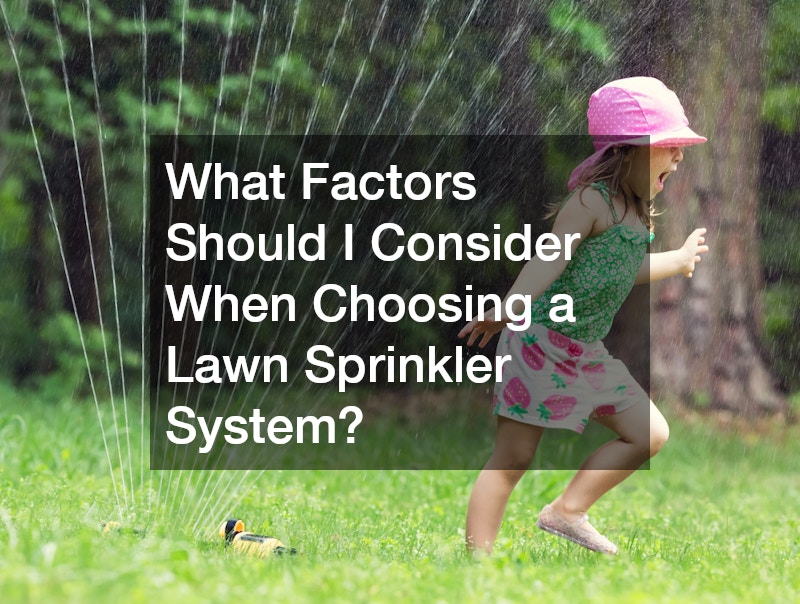A lush, green lawn is a hallmark of a well-maintained home, and one of the most effective ways to achieve this is through a reliable lawn sprinkler system. However, with numerous options available, selecting the right system for your yard can feel overwhelming. In this article, we explore the critical factors to consider when choosing a lawn sprinkler system, the types available, and how to maintain and optimise your system for the best results.
Whether you have a small garden or a sprawling lawn, this comprehensive guide will help you make an informed decision tailored to your outdoor space.
1. What Factors Should I Consider When Choosing a Lawn Sprinkler System?
1.1 Yard Size and Shape
One of the first considerations when selecting a sprinkler system is the size and shape of your yard. A small, rectangular yard may require a simple above-ground sprinkler that can cover the area efficiently without much complexity. On the other hand, larger or irregularly shaped yards often benefit from more advanced systems, such as in-ground sprinklers with multiple zones that allow targeted watering.
The dimensions of your yard determine how many sprinkler heads you need and their placement to ensure even water distribution. Overlapping spray patterns are important to avoid dry spots, and you might need adjustable nozzles to accommodate oddly shaped areas. Understanding your yard’s layout upfront saves time and money and helps prevent overwatering or underwatering.
1.2 Water Pressure and Flow Rate
Water pressure and flow rate from your home’s supply are vital factors affecting sprinkler performance. Sprinkler systems rely on sufficient pressure to deliver water evenly across the lawn. If your pressure is too low, sprinkler heads may not reach the intended coverage area, leading to patchy lawns.
1.3 Climate and Weather Conditions
The climate where you live influences how often and how much you need to water your lawn. Hotter, drier climates require more frequent watering, so durability and water efficiency become crucial in your sprinkler system choice. Conversely, regions with high rainfall might need a system that allows easy scheduling and pausing.
2. What Types of Sprinkler Systems Are Available?
2.1 Above-Ground Sprinkler Systems
Above-ground sprinkler systems are popular for their affordability and ease of installation. These can be portable units like oscillating, rotary, or stationary sprinklers that you place where needed and move around. They are ideal for small to medium-sized yards or temporary watering needs.
2.2 In-Ground Sprinkler Systems
In-ground sprinkler systems offer a seamless, automatic watering experience. Installed beneath the soil, these systems use pop-up sprinkler heads that retract when not in use, keeping your lawn tidy. They are ideal for medium to large yards and can be customised into multiple zones to water different areas according to their specific needs.
2.3 Drip Irrigation Systems
Drip irrigation systems are a water-efficient option designed for precise watering. Instead of spraying water over a broad area, drip systems deliver water slowly and directly to the roots through tubing and emitters. This reduces water waste due to evaporation or runoff and is especially suitable for gardens, flower beds, and landscaped areas.
3. How Do I Maintain and Optimise My Sprinkler System?
3.1 Regular Inspection and Maintenance
Routine maintenance is essential to keep your sprinkler system running efficiently. Regularly inspect sprinkler heads for clogs, leaks, or damage. Broken heads or misaligned nozzles can lead to uneven watering and wasted water.
Check for leaks in the piping and ensure the timer and valves function correctly. Cleaning filters and flushing the system at least once a year prevents buildup that might impair performance. Simple upkeep extends the system’s lifespan and saves on costly repairs.
3.2 Seasonal Adjustments and Timing
Your lawn’s watering needs change throughout the year, so adjust your sprinkler system accordingly. During cooler months or rainy seasons, reduce watering frequency or turn the system off to avoid overwatering. In contrast, increase watering during dry spells or summer heat.
3.3 Using Smart Technology and Sensors
Modern sprinkler systems increasingly incorporate smart technology and sensors to optimise watering. Rain sensors can automatically pause watering during rainfall, while soil moisture sensors detect when your lawn needs water.
Choosing the best lawn sprinkler system involves assessing your yard’s size, water supply, and climate, then selecting a system that fits those needs—whether it’s a portable above-ground sprinkler, a sophisticated in-ground system, or a precise drip irrigation setup. Proper maintenance and the use of modern smart technology further enhance efficiency, helping you conserve water while keeping your yard lush and healthy. By focusing on these key factors, you can create a watering strategy that meets your lawn’s unique requirements all year round.



